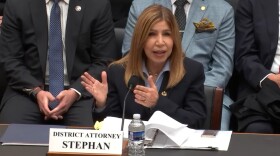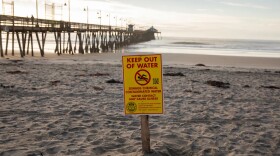>>> You are listening to KPBS Midday Edition I am Allison St. John in for Maureen Cavanaugh. As we enter another day of the unfolding drama for Trump zero-tolerance policy new questions arises about how to break the law without working moral codes. He signed a rule stating he will stop taking babies from parents but there are lot of rules about enforcing the law. With us right now is Ed, thank you for joining us. The reason families were being separated in the first place is because of the 1997 floors ruling that the Florez rolling where it calls for the Attorney General to request for California courts to modify that decision. How likely is it that that law can be change. >> I think it is unlikely. Congress will have to take a legislative initiative. The fact with this role is it has been the guide for how we deal with minors in our system period. It was designed in 1993. The consent decree was from 1997. It was a necessary roadmap because it was preceded by a terrible series of abuses of children in immigration custody. Many of them by subcontractors. That is the only real guideline we had. The only exception is the 2008 law for trafficking victims. It set up the system for unaccompanied minors. So we have to write a new law. I don't think the courts in California and the federal courts will do that on their own. >>> If the law is not changed how does that play out? >> First, the grace period of 20 days that was given by a judge in granting successful challenge of the Obama administration's detention of families for immigration purposes not for criminal purposes. The judge said you cannot do that it violates the consent decree. You can have 20 days. The administration took it out of context and set in this world we will write 20 days in. They are not dealing with the core of the issue. The core of the issue and the substance of the consent decree is we should avoid detaining children and separating families at all costs per when children are detained it should be in the least restrictive conditions as possible. We should have serious standards for the conditions of the Detention. We have seen nothing like that from the president. It will be challenged in court. What I will say is the administration likes this -- likely knows this and the wording of the title of the executive order itself suggests that they know it is temporary. They are not trying to make policy. They are trying to negotiate with Congress. >>> At the same time instructions are going out to get more judges. Isn't there a huge backlog in judges to try to reduce the amount of time these cases take? How realistic would it be to reduce the amount of time for these court cases? >> The federal court has two dockets. For the federal immigration docket, there is a backlog of 700,000 cases which is why there's a weight of up to five years. In criminal courts, we don't have that yet. If we continue to prosecute thousands and thousands of these illegal entry cases, we will end up with a backlog of federal courts. It depends on how they set their priorities. That is important. That speaks of the opportunity cost. To prosecute these cases, there are other federal criminal cases we are not prosecuting. >>> How big of a threat is this to national security and our legal system. Is immigration worth spending these resources on? >> That is a good question. We are overdue for a serious conversation about that. Why are we tasking tens of thousands of federal personnel, spending $175 a night for a to take in center holding 65 to 75,000 people on any given day. Why we are spending in criminal prosecutions upwards of $150 an hour for federal public defenders to defend cases we know will get the minimum sentence were most people are pleading guilty. There is a real question about the use of resources. Setting aside the question of cost, we have to talk about the security piece. How are these children and families threat to national security? I don't see it. I see other threats of national security we are not addressing. >>> Finally, family separations have been happening in this country for a long time. Talk about how this issue is a bigger picture. >> That is an important issue and that is missing. The public attention was grabbed by these young kids separated suddenly from their parents. I think it was also grabbed by the fact that this was done as a negotiating ploy with Congress. And I think the people in the administration admitted that at this point. The fact is, over the last 20 years we have gone down a new path of immigration policy. This is not something that is Republican or Democrat it is bipartisan. It is the law of the land. All harsh immigration policy separates families. I spent a good amount of time in Saturday's until one of visiting migrant farms. They were all different kinds of deported migrants separated from their kids for long periods of time. >>> And there are many children in San Diego right now living without their parents. >> We have tens of thousands of parents -- kids in Southern California missing mom and dad in living in other arrangements. We never thought about the social, cultural, educational cost of that. What it does to our -- their families in our communities. That discussion is missing in our immigration discussion the way the politics have been framed. I think the administration has made this case for making these criminal prosecutions. They made it as a deterrence case. They never really told us with the nature of the threat is. I think it is fair to ask if we are framing children as a threat. Are we changing the demographic change in the United States at the national security threat. If that is the conversation, we have some serious soul-searching to do. >>> We will see how this plays out. Thank you very much, Ed.
President Trump signed an executive order on Wednesday ending his administration's policy of separating migrant children from their parents who were detained as they attempted to enter the U.S. illegally.
The action came after a firestorm of protest from administration opponents and allies, reacting to pictures and sounds of young children traumatized by their separation from their parents at the hands of U.S. authorities.
"So we're going to have strong — very strong borders, but we're going to keep the families together. I didn't like the sight or the feeling of families being separated," said Trump.
He is, in effect, ordering family separation to be replaced with the detention of whole families together, even after earlier arguing that "you can't do it by executive order."
What does the executive order say?
The president says his administration is trying to balance rigorous enforcement of U.S. immigration laws and pursue its policy of maintaining family unity. He says his administration was put "in the position of separating alien families to effectively enforce the law" because of "Congress's failure to act" and "court orders."
What court orders is he talking about?
The administration has consistently said that it was forced to separate families because of a court case known as "the Flores Settlement." That settlement, reached in 1997, required the government to limit the time it kept unaccompanied minors in detention and to keep them in the least restrictive setting possible. The settlement was later modified to say that children should not be held longer than 20 days.
Trump's executive order directs the attorney general to promptly file a request with U.S. District Judge Dolly Gee in the Central District of California to modify the Flores Settlement and allow detained migrant families to be held together "throughout the pendency of criminal proceedings ... or other immigration proceedings."
What else did Trump order?
The president directed Homeland Security Secretary Kirstjen Nielsen to maintain custody of detained families during criminal proceedings and as their asylum claims are adjudicated. Also, Secretary of Defense Jim Mattis and the heads of other agencies are ordered to find or construct facilities to house the detained families. Finally, Attorney General Jeff Sessions is directed to prioritize the adjudication of cases involving detained families.
What does the executive order mean for the plans of House Republicans to pass their own legislation to address the crisis?
After visiting Capitol Hill Tuesday night to rally a broad immigration bill, Trump said Wednesday he still hopes that Congress will act.
"We will be going through Congress. We're working on a much more comprehensive bill," Trump said before signing the order. But as The Washington Post reports, few people are predicting either House measure will pass.
So what happens to the children who have been separated from their parents?
It is not immediately clear whether, or when, detained children will be reunited with their parents.
"It is still very early and we are awaiting further guidance on the matter," said Brian Marriott, senior director of communications at the Administration for Children and Families, a division of Health and Human Services. "Our focus is on continuing to provide quality services and care to the minors in HHS/[Office of Refugee Resettlement] funded facilities and reunifying minors with a relative or appropriate sponsor as we have done since HHS inherited the program. Reunification is always the ultimate goal of those entrusted with the care of [unaccompanied children], and the administration is working towards that for those [unaccompanied children] currently in HHS custody."
Reyna Torres Mendivil, Mexico's consul general in San Antonio, told NPR's Audie Cornish that the process would be hampered by the U.S. separation process, which keeps parents in ICE custody while moving children into facilities controlled by the Department of Health and Human Services.
"The U.S. authorities create different files for the children than for the parents, and it's very difficult to follow up on those cases," Torres said.
What's the reaction to the executive order?
Immigrant advocates say the president's executive order is no solution, and will only create more trauma for children, as they will be placed in facilities that are unfit for minors.
"First, there are more than 2,000 children already separated from their parents; the executive order does nothing to address that nightmare," said Michelle Brané, director of the Migrant Rights and Justice Program at the Women's Refugee Commission. "Second, this executive order effectively creates family prisons, which we already know are a threat to the well-being of children."
"The president doesn't get any Brownie points for moving from a policy of locking up kids and families separately to a policy of locking them up together," said Karen Tumlin, director of legal strategy at the National Immigration Law Center. "Let's be clear: Trump is making a crisis of his own creation worse."
Some on the right are equally dismayed.
"According to any fair reading of the order, it represents a massive capitulation by the administration," wrote National Review senior writer David French.
But Mark Krikorian, executive director of the D.C.-based Center for Immigration Studies, which supports less immigration, supported the president.
"Getting rid of the Flores Settlement is the quickest way to solve the problem," Krikorian told The Washington Post. "The government has been faced with the choice of either splitting the family by detaining the parent and releasing the kid, or just letting the parent go too."
Copyright 2018 NPR. To see more, visit http://www.npr.org/.






